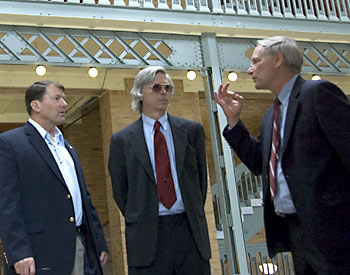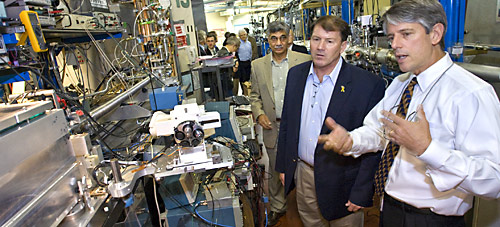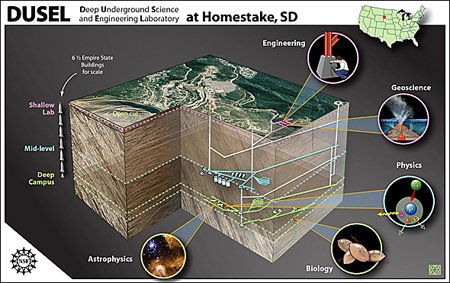Berkeley stakes science claim at Homestake gold mine

South Dakota Gov. Mike Rounds paid a visit to UC Berkeley and Berkeley Lab last Friday (June 12) to get a feel for the type of research operation the campus and the lab plan to build at his state's famed Homestake gold mine.
Rounds has strongly supported efforts to turn the mine, founded in 1877 by mining magnate and California Sen. George Hearst and taken out of operation in 2002, into the world's premier underground research laboratory, and the only one capable of answering critical questions about the nature of the elusive neutrino, a nearly massless sub-atomic particle that rarely interacts with matter. The DUSEL facility will host experiments in a range of fields, including physics, earth sciences, biology and engineering, as well as a major education and outreach program.
"We felt it was important to come out and see what the University of California has already completed and coordinated in terms of science facilities, in particular the labs like Berkeley Lab, and to develop long term, lasting relationships with people who are actively involved in the science community," Rounds said. "We in South Dakota are in the primary stage of welcoming research into our state and providing the necessary resources to make it successful. To come here and see how it's done gives us a chance to understand what the science community's expectations are."
"We are excited by the tremendous progress being made at Homestake and by the DUSEL science team," said UC Berkeley Chancellor Robert Birgeneau, who breakfasted with Rounds. "DUSEL is a very important project, not only for the campus, the lab and South Dakota, but also for science, addressing some of the deepest questions about the very nature of the universe."
UC Berkeley physicist and Berkeley Lab researcher Kevin Lesko escorted Rounds and a small entourage on a tour of the Hearst Mining Building and Stanley Hall, as well as Berkeley Lab's Advanced Light Source and National Center for Electron Microscopy. Lesko is spearheading the collaboration with the National Science Foundation (NSF) to create at the Homestake mine the Deep Underground Science and Engineering Laboratory (DUSEL), which, at an existing depth of 8,000 feet, would be the deepest experimental lab in the world.
"The Homestake mine is the crown jewel for our research opportunities," said Rounds, who anticipates a major economic and academic stimulus from a high-profile national laboratory in South Dakota.
So far, the South Dakota legislature has ponied up more than $35 million and applied an additional federal grant to prepare the former mine for science, while South Dakota banker and philanthropist T. Denny Sanford plunked down another $70 million to turn an underground cavern at a depth of 4,850 feet into an experimental chamber to be called the Sanford Underground Science and Engineering Laboratory, or Sanford Lab. These funds are being used to reopen the shafts and install pumping equipment to remove water from the lower levels, which flooded when the mine was decommissioned and the pumps turned off. The water level dipped below 4,850 feet on May 13.

The underground lab will be dedicated June 22, kicking off parallel efforts to prepare underground space to host initial scientific programs while plans for NSF’s DUSEL are prepared.
The first experiment to go into the Sanford Lab will be the Large Underground Xenon (LUX) experiment, which will look for dark matter, a so far unidentified 25 percent of the universe that has been inferred from observations of distant galaxies. Some astrophysicists think dark matter could be comprised of "weakly interacting massive particles," or WIMPS, that would betray their identity by interacting with supercold xenon atoms. The LUX experiment, an international collaboration led by Brown University and Case Western Reserve, will take up residence this summer in newly renovated above-ground buildings while the underground space is readied.
Another experiment destined soon for the mine is Majorana, which will attempt to determine the mass of the neutrino via an hypothesized but rare event, neutrinoless double-beta decay the spontaneous conversion of two neutrons into two protons and two electrons (beta particles) without the emission of a neutrino.For both experiments, an underground site is critical to block cosmic ray particles from space that could mimic the rare events the researchers are trying to discover.
The biggest project proposed for the underground lab is the very long baseline neutrino oscillation experiment, for which a neutrino detector at a 4,850-foot depth would be the target of a neutrino beam aimed from the FermiLab accelerator 813 miles away in central Illinois. Neutrinos rarely interact with matter, which means the neutrino beam could pass underground unperturbed, though scientists hope some of them will interact in the detector and reveal their "flavor." The results will tell researchers which of the three flavors of neutrino is the heaviest and which the lightest, complementing the results of Majorana, as well as refine the determination of the mixing between the three neutrino flavors. The experiment also probes a major symmetry in nature, charge-parity (CP) violation, that might ultimately explain the universe’s matter-antimatter asymmetry .
"Other sites don't go deep enough for some next-generation physics experiments," Lesko said. A majority of DUSEL’s experiments will be housed in cavities excavated off existing drifts – horizontal tunnels with experiments clustered into campuses at the 4,850- and 7,400-foot levels.
One member of Rounds' group was DUSEL project co-principal investigator William Roggenthen, professor of geology and geological engineering at the South Dakota School of Mines and Technology, who is intrigued by the opportunity to drill even deeper into the Earth from the bottom of Homestake. Future plans to drill to 16,000 feet could tell about the movement of fluids in underground cracks and the unique biology of underground microbes, which live at temperatures above the boiling point of water.

As executive project director and principal investigator, Lesko hopes to leverage these state investments to obtain National Science Foundation funds for a more expansive lab to accommodate a variety of experiments. In 2007, when NSF chose Homestake as its preferred location for a deep underground science lab, it awarded UC Berkeley and Lesko $15 million to plan the facility and the experiments. An NSF review in January 2009 resulted in a go-ahead to turn in a proposal for approximately $30 million to complete a preliminary design for the laboratory. That proposal was submitted in May.
"The 25-person review team gave DUSEL a very strong endorsement," Lesko said. "With this good sign, it is the right time for the governor to visit the campus to meet with those, like Graham Fleming and Chancellor Birgeneau, who have shepherded this project along."
Until his appointment as UC Berkeley vice chancellor for research, Fleming served as a member of the Board of Directors of the South Dakota Science and Technology Authority, which oversees the state’s Homestake conversion project.
As construction begins for the Sanford Lab, Lesko is working with many collaborations to develop the scientific programs that will be supported as part of the DUSEL construction project and to integrate into the DUSEL facility design the necessary infrastructure and support services.
"The DUSEL team is seeking ways to exploit synergisms between the different experiments and disciplines and use these very different experiments to create a world-class education and outreach center," Lesko said.
During his tour of Berkeley Lab, Rounds was energized by a discussion about K-12 outreach with educators from the Lawrence Hall of Science and Berkeley Lab's Center for Science and Engineering Education. Rounds said that boosting education efforts in his state was one of his top priorities, and interaction with DUSEL would be key to that effort.
"The biggest problem we have in South Dakota is keeping young people within our state; if we don't provide them with opportunities, they have to go someplace else and we lose their talents," Rounds said. "We want to develop a program that … convinces the scientists that here's a place where they can get teachers and students interested in their story; and convinces teachers that they have an opportunity for them and their kids to participate even teachers who aren’t science teachers."
Rounds noted that the mine was the site of an underground experiment in the 1960s that first measured neutrinos from the sun, earning Raymond Davis Jr. the 2002 Nobel Prize in Physics. In fact, Davis's old lab will be enlarged and renovated to house LUX. Rounds hopes that, whereas Homestake was once known for mining gold, in the future it will be known for mining science.
"There has been one Nobel Prize that has been found there already; we are convinced there will be others in the future," Rounds said.
RELATED LINKS:
• DUSEL home page
• Deep Science
